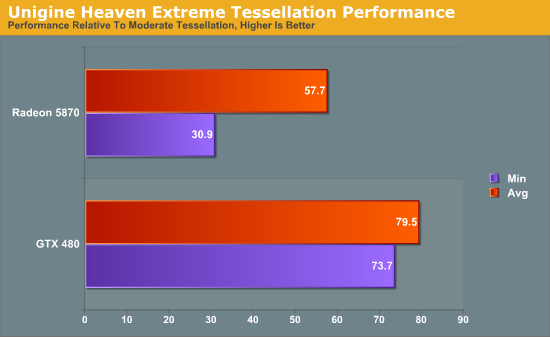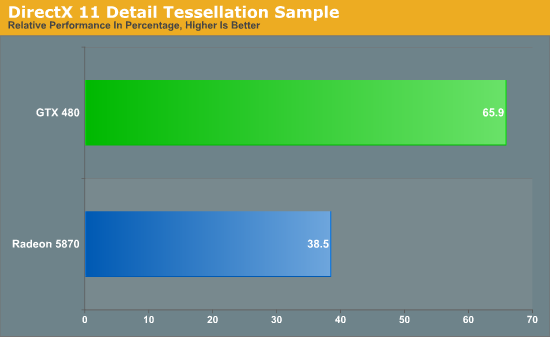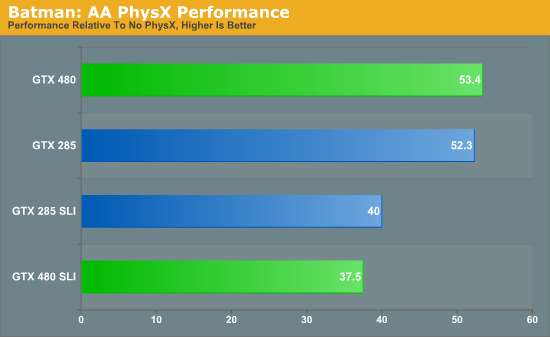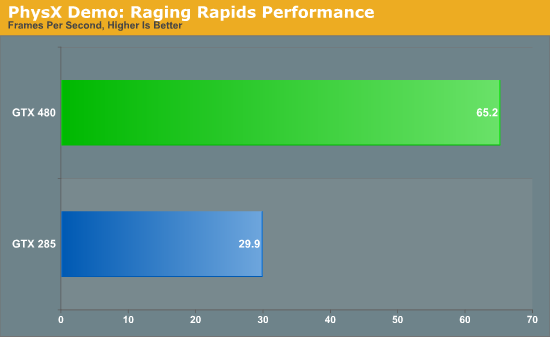NVIDIA’s GeForce GTX 480 and GTX 470: 6 Months Late, Was It Worth the Wait?
by Ryan Smith on March 26, 2010 7:00 PM EST- Posted in
- GPUs
Tessellation & PhysX
We’ll kick off our in-depth look at the performance of the GTX400 series with Tessellation and PhysX. These are two of the biggest features that NVIDIA is pushing with the GTX400 series, with tessellation in particular being the major beneficiary of NVIDIA’s PolyMorph Engine strategy.

As we covered in our GF100 Recap, NVIDIA seeks to separate themselves from AMD in spite of the rigid feature set imposed by DirectX 11. Tessellation is one of the ways they intend to do that, as the DirectX 11 standard leaves them plenty of freedom with respect to tessellation performance. To accomplish this goal, NVIDIA needs significantly better tessellation performance, which has lead to them having 14/15/16 tesselators through having that many PolyMorph Engines. With enough tessellation performance NVIDIA can create an obvious image quality improvement compared to AMD, all the while requiring very little on the part of developers to take advantage of this.
All things considered, NVIDIA’s claim of having superior tessellation performance is one of the easiest claims to buy, but all the same we’ve gone ahead and attempted to confirm it.
Our first tessellation test is the newly released Unigine Heaven 2.0 benchmark, which was released a few days ago. 2.0 added support for multiple levels of tessellation (with 1.0 having earned a reputation of using extreme levels of tessellation), which allows us to look at tessellation performance by varying tessellation levels. If the GTX 480’s tessellation capabilities are several times faster than the Radeon 5870’s as NVIDIA claims, then it should better handle the increased tessellation levels.
Since Heaven is a largely a synthetic benchmark at the moment (the DX11 engine isn’t currently used in any games) we’ll be focusing on the relative performance of cards to themselves in keeping with our editorial policy of avoiding synthetic GPU tests when possible.

Heaven: Moderate & Extreme Tessellation
Heaven has 4 tessellation levels: off, moderate, normal, extreme. For our test we’re using the moderate and extreme modes, comparing the performance of extreme as a percentage of moderate performance.

Starting with averages, the GTX 480 keeps 79% of its performance moving from moderate to extreme. On the Radeon 5870 however, the performance drop-off is much more severe, losing 42% of its performance to bring it down to 58%.
The minimum framerates are even more telling. The GTX 480 minimum framerates drop by 26% when switching to extreme tessellation. The Radeon 5870 is much worse off here, bringing in minimum framerates 69% lower when using extreme tessellation. From these numbers it’s readily apparent that the GTX 480 is much more capable of dealing with very high tessellation levels than the Radeon 5870 is.
Our second tessellation test is similar in nature, this time taken from one of Microsoft’s DX11 sample programs: Detail Tessellation. Detail Tessellation is a simple scene where tessellation plus displacement mapping is used to turn a flat rock texture in to a simulated field of rocks by using tessellation to create the geometry. Here we measure the average framerate at different tessellation factors (7 and 11) and compare the framerate at the higher tessellation factor to the lower tessellation factor.


Looking at just the averages (the framerate is rather solid) we see that the GTX 480 retains 65% of its performance moving from factor 7 to factor 11. The Radeon 5870 on the other hand only retains 38% of its performance. Just as what we saw in Unigine, the GTX 480 takes a much lighter performance hit from higher tessellation factors than the Radeon 5870 does, driving home the point that the GTX 480 has a much more powerful tessellator.
With the results of these tests, there’s no reason to doubt NVIDIA’s claims about GF100’s tessellation abilities. All the data we have points GF100/GTX 480 being much more powerful than the Radeon 5000 series when it comes to tessellation.
But with that said, NVIDIA having a more powerful tessellator doesn’t mean much on its own. Tessellation is wholly dependent on game developers to make use of it and to empower users to adjust the tessellation levels. Currently every DX11 game using tessellation uses a fixed amount of it, so NVIDIA’s extra tessellation abilities are going unused. This doesn’t mean that tessellation will always be used like this, but it means things have to change, and counting on change is a risky thing.
NVIDIA’s superior tessellation abilities will require that developers offer a variable degree of tessellation in order to fully utilize their tessellation hardware, and that means NVIDIA needs to convince developers to do the extra work to implement this. At this point there’s no way for us to tell how things will go: NVIDIA’s superior tessellation abilities could be the next big thing that seperates them from AMD like they’re shooting for, or it could be the next DirectX 10.1 by being held back by weaker hardware. Without some better sense of direction on the future use of tessellation, we can’t make any recommendations based on NVIDIA’s greater tessellation performance.
Moving on we have PhysX, NVIDIA’s in-house physics simulation middleware. After picking up PhysX and its developer AGEIA in 2008, NVIDIA re-implemented PhysX hardware acceleration as a CUDA application, allowing their GPUs to physics simulations in hardware. NVIDIA has been pushing it on developers and consumers alike with limited success, and PhysX only finally had a breakthrough title last year with the critically acclaimed Batman: Arkham Asylum.
With Fermi’s greatly enhanced compute abilities, NVIDIA is now pushing the idea that PhysX performance will be much better on Fermi cards, allowing developers to use additional and more complex physics actions than ever before. In particular, with the ability to use concurrent kernels and the ability to do fast context switching, PhysX should have a reduced degree of overhead on Fermi hardware than it did on GT200/G80 hardware.
To put this idea to the test, we will be using the Batman: Arkham Asylum benchmark to measure PhysX performance. If PhysX has less overhead on Fermi hardware then the framerate hit on the GTX 480 from enabling PhysX effects should be lower than the framerate hit on the GTX 285. For this test we are running at 2560x1600, comparing performance between PhysX being disabled and when it’s set on High.

If PhysX has less overhead on Fermi hardware, Batman is not the game to show it. On both the GTX 480 and the GTX 285, the performance hit on a percentage basis for enabling PhysX is roughly 47%. The GTX 480 may be faster overall, but it takes the same heavy performance hit for enabling PhysX. The SLI cards fare even worse here: the performance hit for enabling PhysX is 60% on both the GTX 480 SLI and the GTX 285 SLI.
PhysX unquestionably has the same amount of overhead on the GTX 480 as it does the GTX 285. If PhysX is going to take up less overhead, then from what we can gather it either will be a benefit limited to PhysX 3, or will require future PhysX 2.x updates that have yet to be delivered.
Or second PhysX test is a more generalized look at PhysX performance. Here we’re using NVIDIA’s Raging Rapids tech demo to measure PhysX performance. Raging Rapids is a water simulation demonstration that uses PhysX to simulate waves, waterfalls, and more. Here we are measuring the framerate in the demo’s benchmark mode.


Overall the Raging Rapids benchmark gives us mixed results. Out of all of the benchmarks we have run on the GTX 480, this is one of the larger performance jumps over the GTX 285. On the other hand, once we compensate for the GTX 480’s additional shaders, we end up with a result only around 10% faster than a strict doubling in performance. This is a sign of good scaling, but it isn’t a sign that the GTX 480 is significantly faster than the GTX 285 due to more efficient use of compute resources. Just having all of this extra compute power is certainly going to make a difference overall, but on an architectural level the GTX 480 doesn’t look to be significantly faster at PhysX than the GTX 285 on a per-clock/per-shader basis.











196 Comments
View All Comments
Sunburn74 - Sunday, March 28, 2010 - link
It is absolutely ridiculous. Like having a buzzsaw in your case.http://www.hardocp.com/article/2010/03/26/nvidia_f...">http://www.hardocp.com/article/2010/03/26/nvidia_f...
Belard - Sunday, March 28, 2010 - link
AMD already stated they are not reducing their pricing any time soon. This is because their line-up is far healthier than Nvidia.They know (and we should know) that the $500/$350 price for the new GeForce 4 cards are not going to stick. There is only some many thousands of cards available for the next 3~5 months. The supply will run dry in about 1-3 weeks I bet. We're going to see the pricing shoot up close to $600 for the GF480, the fanboyz will be willing to pay that price.
The 5850 was supposed to be a $250 card, we see how well that worked out. While the price did settle around $300, the 5850 was still a better value than the $370~400 GeForce 285 card as it was far faster and run cooler, etc. The 5870 is typically faster than the $500 GeForce 295 - for $100 less. ATI has no reason to lower their pricing.
The GeForce 265~295 cards are already being phased out, too slow, cost too much.
So nVidia has nothing for the sub $300 market... nothing. Only the GF-250 has any value but a tad expensive as it should be $100 since its still a DX10 re-badged 9800GTX.
So when ATI feels any pressure from Nvidia, they can easily drop their prices. It costs $5000 per wafer, no matter how many chip dies are on it. It may be costing nVidia $150~200 per chip while for AMD, they could be paying $20~35 per chip used in the 5800/5900s.
Then you add the costs for memory, the PCB, parts, cooling system etc.
It is very easy for AMD to drop $50 per GPU and they'd still make a profit while Nvidia sells their geForce 400 cards at a loss or no profit.
When ATI sells the 5830 for $190~200, 5850 at $250 and 5870 at $325~350 would help sales and keep nVidia at bay.
We'll see...
SirKronan - Sunday, March 28, 2010 - link
I would've liked to see 5850's in crossfire thrown into this mix. I know you don't have time to test them all, but I think that's the key competitor against the 480 when it comes to bang/buck. I would think the 5850's in crossfire could handily beat the 295 and the 480, all while consuming less power. I believe there may have been another site that did it, but with this excellent and very thorough review done here, it would've been even that little tiniest bit sweeter to have a 5850 crossfire line on their graphs.Regardless, thanks for the informative review!
B3an - Saturday, March 27, 2010 - link
This review and any other pages on this site are not working in Firefox... they have been reported as attack pages."This web page at www.anandtech.com has been reported as an attack page and has been blocked based on your security preferences."
This is why FF with all default settings, and just using adlock.
Could it be trouble with the ads again using a malware/virus?
Ryan Smith - Sunday, March 28, 2010 - link
We know. It's being worked on.Sunburn74 - Saturday, March 27, 2010 - link
The 5850 idles inthe mid 30's but it also does absolutely nothing to stay cool, operating at about 20% max fan speed. Under load it may go up to 30% fan speed, but rarely ever breaks the 40% mark.What are the approximate idle and load fan speeds for both the gtx 480 and 470? I guess I'm asking this to understand just how much extra cooling room is innately available. Are these card working at max capacity to keep cool or is there thermal/fan headroom there to be had?
Ryan Smith - Saturday, March 27, 2010 - link
I don't have that data on-hand (we don't record fan speeds), but it's something that I should be able to easily grab at a later time.Lemonjellow - Saturday, March 27, 2010 - link
For some reason Chrome is flagging this article as a malicious sight... Oddness... Possibly got a bad advertisement...NJoy - Saturday, March 27, 2010 - link
well, Charlie was semi-accurate, but quite right =))What a hot chick... I mean, literately hot. Way too hotWiNandLeGeNd - Saturday, March 27, 2010 - link
Looking back at the data, I realized that power consumption is for system total. Guru3d measured the power consumption of the card itself and reported a max of 263W, so roughly 21 A. I think my 850W will do just fine since each PCI-X con has 20A each.